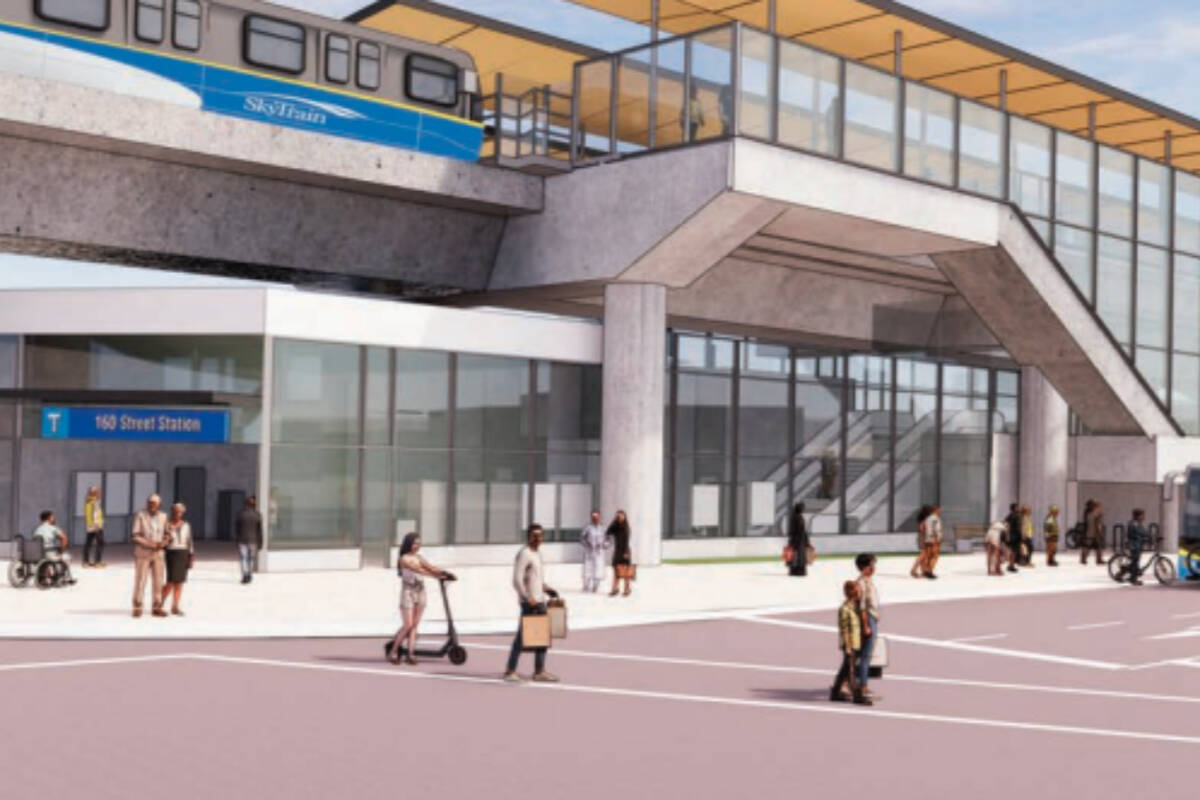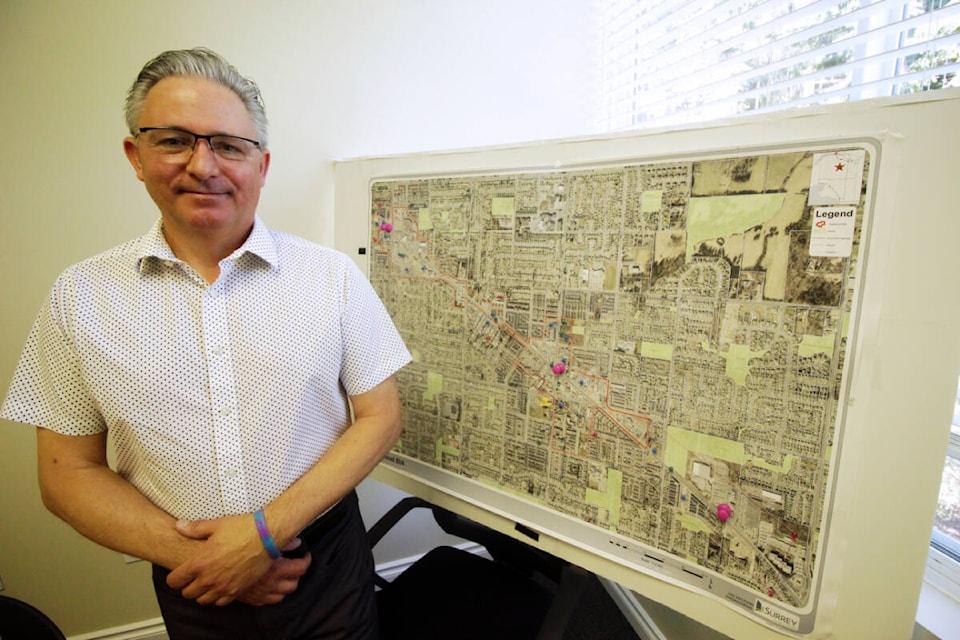This is the second part in our four-part series on the Surrey-Langley SkyTrain extension.
To read the first part, “What are the next steps for the Surrey-Langley SkyTrain project?”, click here.
If you ask Dean Barbour about the Surrey-Langley SkyTrain extension, he’ll show you a map.
“This is, what I call, the story of Fleetwood,” said Barbour, executive director of the Fleetwood Business Improvement Association. “Whether it’s a politician, or whether it’s anybody who has interest, when I lay this out for people, it’s a completely different animal.”
That map shows Fleetwood town centre and is marked with different sizes of pins, connected with thread of various colours. Red thread outlines the catchment area for the Fleetwood BIA.
“These are the properties that pay into the levy that give us the funds to be able to do the work that we do,” he said.
There are about 120 properties and about 400 “mostly” small businesses in the catchment, he said, adding there are undeveloped properties within the area “that will be developed” with the future SkyTrain line.

Large pink pins show the planned stations at 152 Street, 160 Street and 166 Street, while pink thread shows the 200-metre area from the SkyTrain guideway that will have noise and vibration impacts.
“There’s a number of other smaller-scale developments in here that were built with the purpose of transit being light-rail, low vibration, low noise — that’s completely changed now. There’s been a number of complaints with TransLink about building near SkyTrains and the noise and vibrations 18 hours a day.”
Back at the map, Barbour said smaller blue pins are what the BIA calls “tier-one developments.”
“Everything there currently, is gone. It will be completely redeveloped. We’re not talking about a strip mall,” Barbour noted.
“When you look at these swathes of land and the development that’s coming with it, we estimate that in this tier-one development as applications come in, of our 400 business members, approximately 100 of them will be gone.”
But Barbour says “the sky’s not falling.”
“A lot of the businesses that are there, they have been there for decades and decades. They’re ready for a retirement cheque. They’re ready to get out of the business they’re in, they’re looking forward to a massive land assembly here and cashing out.”
He noted that he’s heard from other businesses that there are “demo clauses” being included in their lease renewals. That means businesses can be evicted within 90 days.
“It may not be tomorrow, they may not be evicted for five years, but we know that that’s a sign that development is coming.”
With that, Barbour said his role is proactively working with the developers and the businesses. He said plans to work with the developers to find out how much commercial space they’ll have available. From there, he’ll work with the businesses needing to find a new space and what kinds of rents and leases they can work with.
“If I can get them tenants prior to them even having to look for tenants by moving people — successful businesses — that already have local hands in the community and already have customers and they’re making money the day they open their doors.”
As for the business impacts during construction, Barbour said “actual construction disruptions are less with SkyTrain, the impacts are actually less. Outside of the stations, the guideways are actually not very big.”
“If it was light rail going down the centre of Fraser Highway, it would be a mess.”
Barbour also worked with business during the construction of the Canada Line in Vancouver and Richmond, and part of that line is a cut-and-cover, running underground, which is “a different animal entirely,” he noted.
Barbour added the stations are also “not as cumbersome” as they were 30 years ago, with more integration with the community around it.
In total, there will be eight stations along the 16-km extension, with stations at: 140 Street, 152 Street, 160 Street, 166 Street, 184 Street, 190 Street, 196 Street and 203 Street in Langley. The stations have yet to be named.
As for the elevated guideway, when asked about the alignment, Minister of Transportation and Infrastructure Rob Fleming said it will run along both sides of Fraser, “depending on which station you’re entering into.”
“It will go on both sides and some of it was in respect of the landscape and the environment and the tree canopy.”
The SkyTrain will run along the centre of Fraser Highway from King George Station to 152 Street. From there, the line will move to the north side of Fraser until just after the 166 Street. The guideway will move briefly to the centre, and then move to the south side through the Agricultural Land Reserve area, before moving back to the centre just before 184 Street.
From there, the SkyTrain will move back to the north side of Fraser until moving to the south side of Industrial Avenue once it gets into downtown Langley.
Meantime, Cory Redekop, the CEO of the Greater Langley Chamber of Commerce, said this line is a “generational opportunity to invest in livability, sustainability and success of the Langleys, and frankly, the entire south of the Fraser region.”
Redekop made the comment during the province’s announcement on July 14 about the business case being formally approved.
“It’s going to serve as a catalyst for creating exciting, new commercial and retail and mixed-use space for our businesses to move into, to grow.”
But for Barbour, he said his goal for the line through the Fleetwood town centre, and the BIA catchment area, is “not to recreate Fleetwood.
“I worked with the businesses and the Cambie Business Improvement Association and I can tell you 85 per cent of those businesses – all of them small businesses – are either gone or they’ve moved. If you go down there now, you’d never know they existed. But a part of that history, a part of that community died.”
Barbour noted Fleetwood is more than 100 years old, with a “rich” history.
“Because we build towers and sidewalks doesn’t mean that we have to forget the community of Fleetwood.”
NEXT WEEK: Part three of our series looks at the development planned for the areas around – and along – the route.
lauren.collins@surreynowleader.com
Like us on Facebook Follow us on Instagram and follow Lauren on Twitter
